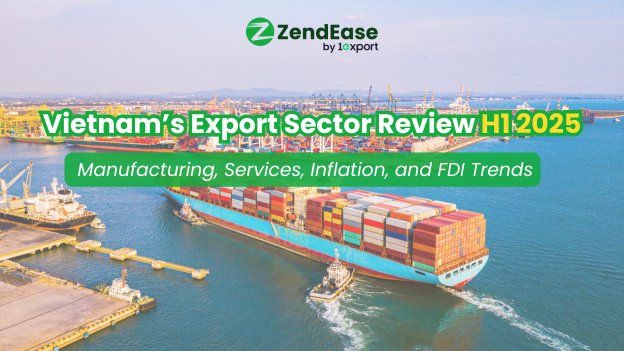Vietnam’s Export Sector Review H1 2025: Manufacturing, Services, Inflation, and FDI Trends
by Ly Nguyen on Oct 23, 2025

Vietnam’s export sector continues to be a key driver of economic growth, contributing significantly to GDP, foreign currency inflows, and employment. In the first half of 2025 (H1 2025), the sector has navigated global demand fluctuations, inflationary pressures, and evolving foreign direct investment (FDI) patterns, challenging exporters to adapt strategically.
This review highlights the latest trends in manufacturing, services, inflation, and FDI, offering practical insights for businesses exploring opportunities in Vietnam’s export markets.
1. Manufacturing Exports: Resilience and Innovation
Manufacturing remains the backbone of Vietnam’s export economy. H1 2025 saw steady growth despite global uncertainties, particularly in electronics, textiles, and machinery.
- Electronics and high-tech: Electronics exports account for around 40% of total export revenue, driven by smartphones, laptops, and semiconductor components produced in northern industrial hubs. Multinational corporations (MNCs) continue to invest, bringing advanced technology and know-how.
- Textiles and garments: Despite competition from Bangladesh and India, Vietnamese firms leverage fast turnaround times, sustainable production, and diversified sourcing to maintain market share in Europe and North America.
- Innovation as a buffer: Companies adopting automation, lean manufacturing, and digital supply chain management are better able to maintain margins and cope with labor or input cost challenges.
SMEs, however, often face difficulties in scaling operations and meeting international compliance standards, highlighting the importance of strategic partnerships and knowledge transfer.
2. Services Exports: Tourism and IT on the Rise
While manufacturing dominates, services are increasingly important.
- Tourism rebound: International arrivals surged in H1 2025, boosted by eased travel restrictions and campaigns showcasing Vietnam’s culture and natural beauty. Tourism-related services — including hospitality, transportation, and entertainment — have contributed significant foreign currency inflows.
- Digital services: Vietnam’s IT outsourcing, fintech, and e-commerce logistics sectors are growing fast. Competitive labor costs and English-speaking tech talent attract international contracts, positioning the country as a regional digital services hub.
- Logistics and trade facilitation: Integrated solutions for warehousing, fulfillment, and cross-border delivery help exporters — especially SMEs — reach global markets more efficiently.
Together, these service sectors are diversifying Vietnam’s export profile, reducing dependence on manufacturing alone.
3. Inflation and Currency Dynamics: Managing Cost Pressures
H1 2025 experienced moderate inflation, with the consumer price index (CPI) up about 3.2% year-on-year, slightly above government targets.
- Input costs: Rising prices for raw materials, energy, and labor have put pressure on manufacturing margins.
- Export competitiveness: The Vietnamese dong has remained relatively stable against major currencies, but exporters should stay alert to fluctuations that could impact pricing or contract terms.
Proactive measures like bulk procurement, energy efficiency, and digital supply chain management have helped companies mitigate these cost pressures.
4. Foreign Direct Investment: Strategic Growth and Technology Transfer
FDI remains a crucial pillar supporting Vietnam’s exports. Key trends in H1 2025 include:
- Sector focus: Electronics, precision machinery, and renewable energy continue to attract most investments.
- Regional hubs: Northern industrial zones (Bac Ninh, Hai Phong) and southern clusters (Ho Chi Minh City, Binh Duong) remain preferred destinations due to skilled labor and developed infrastructure.
- Technology and skills transfer: FDI inflows help domestic firms adopt advanced production methods and improve quality standards.
Strategic FDI not only expands export capacity but also enhances Vietnam’s global competitiveness in high-value sectors.
5. Opportunities and Practical Insights
H1 2025 highlights several actionable opportunities:
- Supply chain diversification: Expanding networks across provinces or ASEAN countries reduces dependency on a single source.
- Sustainable practices: ESG-aligned operations improve access to environmentally conscious international buyers.
- Digital transformation: Automation, AI-driven logistics, and e-commerce solutions improve efficiency and reduce costs.
- Emerging sectors: Agribusiness, renewable energy, and digital services are showing promising growth alongside traditional manufacturing.
Example: A mid-sized electronics company in Bac Ninh leveraged FDI-backed technology to increase production efficiency by 20%, allowing it to secure new European contracts while maintaining competitive pricing. This illustrates the value of technology adoption and strategic partnerships in sustaining growth.
6. Outlook for H2 2025
Vietnam’s export sector is expected to maintain steady growth in H2 2025, driven by continued global demand, FDI inflows, and domestic policy support.
- Global market volatility: Exporters must stay flexible amid shifts in US–China trade, European demand, and energy price changes.
- Policy support: Government measures stabilizing inflation, facilitating trade, and encouraging FDI will be important for sustained momentum.
- Talent development: Upskilling workers in high-tech manufacturing and IT services is essential for long-term competitiveness.
Vietnam’s adaptable and resilient export ecosystem positions it as an increasingly attractive partner in global trade.
Conclusion
H1 2025 shows that Vietnam’s export sector is resilient and adaptable, with manufacturing anchoring growth, services expanding, and FDI supporting technology and skill development. Despite global uncertainties, the market continues to offer opportunities for exporters, investors, and businesses looking to engage with Vietnam.
If you want to stay updated on the latest trends and insights in Vietnam’s export market, follow ZendEase for regular updates and analysis on exports, FDI, and logistics. You can also subscribe to our newsletter to get practical insights straight to your inbox, or reach out if you want to discuss market trends and trade opportunities.